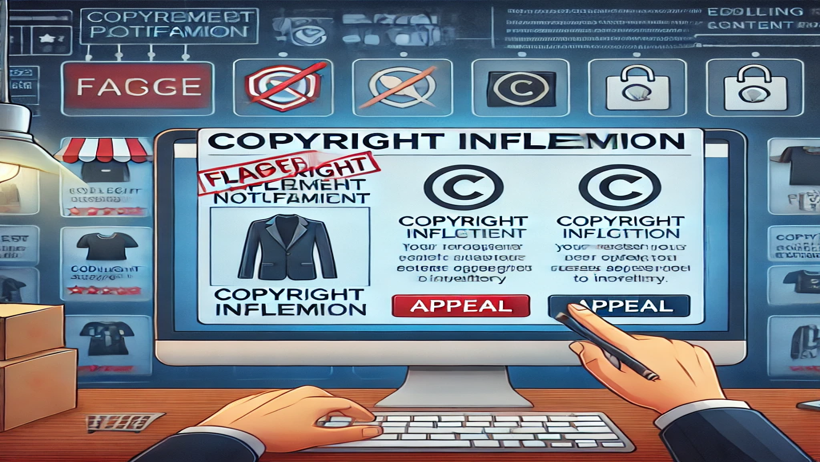How to Recover Your Inventory After a Copyright Infringement Claim
If you’ve recently found yourself unable to access your inventory or listings on a platform due to a copyright infringement claim, you’re not alone. Many sellers encounter this issue, and while it can be disheartening, there are several strategies you can pursue to resolve it and potentially regain access to your products.
Understanding Copyright Infringement in E-commerce
Copyright infringement occurs when someone uses another’s original work without permission, whether it’s an image, text, logo, or even product design. E-commerce platforms enforce copyright rules strictly, as they are liable to be held accountable for violations that occur on their sites. Consequently, when a copyright claim is lodged against your product, your listings may be deactivated, and your inventory may be restricted. Understanding why the claim was made and what your options are will help you resolve the issue.
Solution Methods to Reclaim Your Inventory
1. Review the Copyright Claim Details Carefully
Platforms like Amazon, eBay, and Etsy usually provide information regarding which copyrighted material is in question and who filed the complaint. Here’s what you can do:
- Access Platform Notifications: Check for emails or notifications about the claim. These usually include the alleged copyrighted content, complainant’s details, and instructions for addressing the issue.
- Document the Issue: Keep records of all correspondence and details related to the claim, including dates, times, and communication with the platform or the complainant.
2. Contact the Copyright Owner Directly
If you believe you are authorized to use the content or if the claim was made in error, reaching out to the copyright holder can be an effective first step.
- Request Permission: If you’re using someone else’s intellectual property, seek their permission. In many cases, rights holders will allow you to use their work under specific conditions, such as giving them credit.
- Request Retraction of the Claim: If you can reach an agreement, ask the rights holder to withdraw their complaint. With a retraction, many platforms will allow you to reinstate your listing and regain access to your inventory.
3. Submit a Counter-Notice or File an Appeal
When you believe the claim is mistaken or misapplied, submitting a counter-notice is a formal way to dispute it.
- Check the Platform’s Appeal Process: Each platform has its own guidelines. Follow their process precisely, as failing to meet requirements may lead to further restrictions.
- Provide Supporting Evidence: Include evidence supporting your claim to use the content. This may include original source files, licenses, or receipts showing you purchased the rights to the content.
4. Replace or Modify the Infringing Content
If the copyrighted material is in your listing’s images, descriptions, or other media, updating your listing with original, compliant content can often resolve the issue.
- Use Licensed or Original Content: Replace copyrighted images, text, or other media with your own work or content that you have properly licensed.
- Double-Check Platform Policies: Each platform has specific rules on what is considered acceptable. Ensure your new content fully complies with these rules.
5. Work with a Legal Professional
For complex cases, especially if the claim affects multiple listings or if you’ve been unable to resolve the issue on your own, legal advice can be invaluable.
- Consult a Copyright Attorney: A lawyer specializing in intellectual property can guide you through your rights and help you address the claim effectively.
- Prepare for Future Issues: Working with a legal professional can also help you implement policies to prevent future claims, especially if you frequently use third-party content.
6. Proactively Prevent Future Infringement Issues
To minimize future copyright claims, here are some proactive steps you can take:
- Use Royalty-Free Resources: Many websites offer royalty-free images, music, and other media that are free to use commercially. Examples include Unsplash, Pexels, and Pixabay.
- Create Your Own Content: If possible, produce your own images and descriptions. This reduces the risk of copyright claims and gives your brand a unique touch.
- Understand Copyright Basics: Familiarize yourself with copyright law basics, especially the difference between copyright, trademarks, and patents, to prevent inadvertent violations.
What to Do if Your Counter-Notice is Rejected
In some cases, a counter-notice might be rejected, especially if the platform finds the evidence insufficient or if the complainant maintains their stance. In such cases, consider the following:
- Negotiate with the Platform: Sometimes, platforms allow users to modify the listing or provide additional proof. Reach out to the platform’s support team to discuss alternative resolutions.
- Consider Alternative Platforms: If all attempts to resolve the claim fail, you may wish to explore other sales channels or platforms that do not impose similar restrictions.
Final Thoughts
Recovering inventory after a copyright infringement claim can be challenging, but by understanding the process, contacting the rights holder, submitting a counter-notice if needed, and taking preventive measures, you increase your chances of resolving the issue. While these cases can be frustrating, they also offer valuable lessons in protecting intellectual property and ensuring your listings remain compliant.

